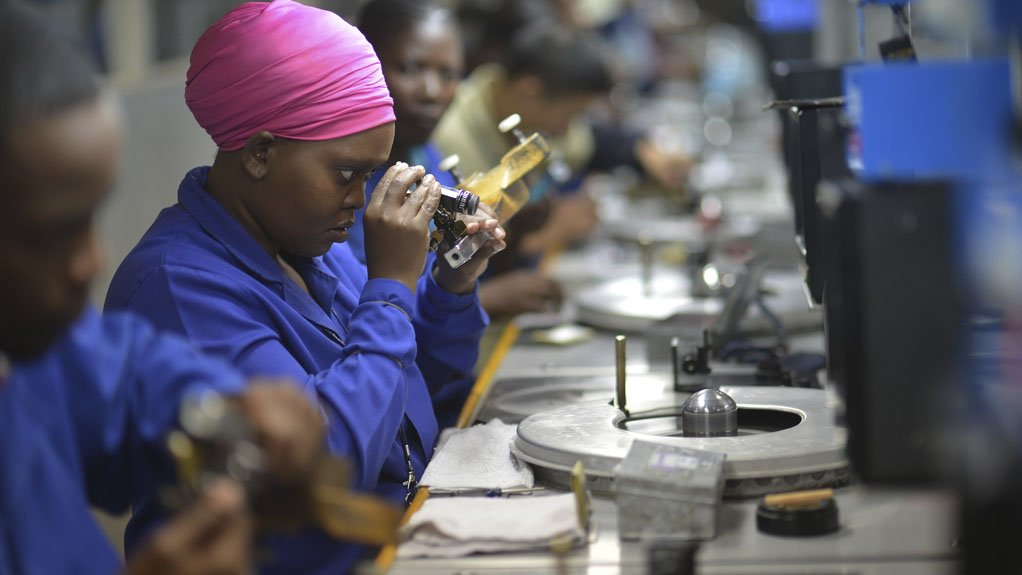Botswana lauded for effectively managing resource rents, but questions linger over diversification



SUBSTANTIAL ECONOMIC CONTRIBUTOR Debswana is the largest corporate entity in Botswana and the largest procurer of goods and services after the government
DIFFICULT DAYS In 2015, diamond cutters MotiGanz, Leo Schachter Diamonds, and Teemane Manufacturing Company closed their plants in Botswana which resulted in 500 job losses
While Botswana’s considerable resource rents have historically been managed effectively by investing in human resources and infrastructure, the country has been unable to effectively diversify its economy and remains highly dependent on the diamond industry.
This is according to a report titled ‘Mining-related national systems of innovation in Southern Africa: National trajectories and regional integration,’ which was recently published by researchers at University of Johannesburg-affiliated research and capacity development group the Centre for Competition Regulation and Economic Development (CCRED).
The report says that this was made possible owing to Botswana’s “strategic relationship” between diamond miner and marketer De Beers, which has a 50:50 joint venture (JV) with the government of Botswana, called Debswana Diamond Company.
The JV is the largest corporate entity in Botswana and the largest procurer of goods and services after the government. The CCRED nonetheless highlights that, as diamond production in Botswana is predicted to decline significantly between 2025 and 2027, the country’s main policy objective in the past two decades has been economic diversification. However, the report states that progress in this direction has not met expectations.
“Although the country’s ranking in international business assessments has improved, this has not translated into an inflow of investment, the economy has not diversified and formal employment growth stems from the public sector only.”
Further, the CCRED points out that economic diversification policies and strategies have been articulated at different levels. Botswana’s National Development Plan 9 (which ran from 2003 to 2009) and National Development Plan 10 (in effect from 2009 to 2016) established six hubs, namely diamonds, health, education, agriculture, innovation and transport.
The Economic Diversification Drive of 2011 to 2016 identifies strategies for market and sector diversification. The report states that, in the short term, the strategy relies on public procurement, but the longer-term goal is to promote internationally competitive enterprises from the primary to the tertiary sectors, such as finance and hospitality.
Mineral beneficiation is included in the strategy and is, indeed, where significant progress has been made. The CCRED notes, however, that diversification into manufacturing is hampered by the fact that Botswana is a small market comprised of about two-million people.
The report comments that the closest market is South Africa which is already saturated and difficult to penetrate. Zambia and Zimbabwe are potential markets, but most domestic firms in Botswana are reluctant to enter these markets owing to high entry costs.
Moreover, the CCRED says that, while Debswana’s procurement is significant, its tenders are too large for local small, medium-sized and microenterprises. However, the report highlights that, in 2014, Botswana’s Chamber of Mines established a Business Development Forum, which is an initiative by the mining industry to create efficiency and realise cost savings for the mining companies, and support enterprise development and economic diversification.
The initiative aims to coordinate purchasing power between the mines to support local suppliers and attract foreign direct investment from original-equipment manufacturers.
Further, the report notes that, in 2005, leveraging off its 50:50 Debswana JV with De Beers at the time of licence renewal, government took the opportunity to adopt a diamond beneficiation policy. The diamond beneficiation policy has been “remarkable” in supporting Botswana’s ambition to move up the global value chain in sorting and valuing, marketing, and polishing and cutting.
A key strategic aspect of the policy is that it was designed around De Beers, which exerts significant market power in domestic and global production, as well as global marketing and distribution channels.
Diamond sorting and valuing for De Beers’ global production have relocated from London, in the UK, to Gaborone, Botswana. To capture a larger share of diamond marketing, Botswana’s government owns Okavango Diamond Company, a distribution company that receives an allocation of 15% of the national output.
The CCRED points out that a large group of representatives of De Beers’ sightholders – more than 80 of the world’s leading diamantaires – travel to Gaborone up to ten times a year, thereby creating additional demand for local goods and services.
The policy also required that at least $500-million a year of De Beers Botswana’s diamond output be reserved for local beneficiation, which was later raised to $800- million a year.
“The policy was well articulated, with clear targets, a combination of export restrictions, penalties and fiscal incentives, private and public investment in public goods and skills, and effective implementation mechanisms,” the report states.
The CCRED notes that diamond cutting and polishing firms are granted licences to operate in Botswana and access reserved diamonds subject to strict local training requirements. According to industry sources, having access to Botswana diamonds is critical, particularly given the large size and high quality of the stones.
“Even if local processing is 15% more expensive than the international benchmark, local beneficiation remained a good investment.
“Employment increased from 2 200 workers in 2008 to 3 750 in 2013.
“In 2015, however, Botswana’s beneficiation strategy was in a serious crisis. The predicament was the result of the misalignment of supply and demand at different stages of the value chain, accompanied by rising prices for rough stones, collapsing demand, and shrinking margins for cutting and polishing firms,” the report explains.
In 2015, diamond cutters MotiGanz, Leo Schachter Diamonds, and Teemane Manufacturing Company closed their plants in Botswana, which resulted in 500 job losses. As firms shut down and retrench workers, the State is not in a position to intervene.
Comments
Press Office
Announcements
What's On
Subscribe to improve your user experience...
Option 1 (equivalent of R125 a month):
Receive a weekly copy of Creamer Media's Engineering News & Mining Weekly magazine
(print copy for those in South Africa and e-magazine for those outside of South Africa)
Receive daily email newsletters
Access to full search results
Access archive of magazine back copies
Access to Projects in Progress
Access to ONE Research Report of your choice in PDF format
Option 2 (equivalent of R375 a month):
All benefits from Option 1
PLUS
Access to Creamer Media's Research Channel Africa for ALL Research Reports, in PDF format, on various industrial and mining sectors
including Electricity; Water; Energy Transition; Hydrogen; Roads, Rail and Ports; Coal; Gold; Platinum; Battery Metals; etc.
Already a subscriber?
Forgotten your password?
Receive weekly copy of Creamer Media's Engineering News & Mining Weekly magazine (print copy for those in South Africa and e-magazine for those outside of South Africa)
➕
Recieve daily email newsletters
➕
Access to full search results
➕
Access archive of magazine back copies
➕
Access to Projects in Progress
➕
Access to ONE Research Report of your choice in PDF format
RESEARCH CHANNEL AFRICA
R4500 (equivalent of R375 a month)
SUBSCRIBEAll benefits from Option 1
➕
Access to Creamer Media's Research Channel Africa for ALL Research Reports on various industrial and mining sectors, in PDF format, including on:
Electricity
➕
Water
➕
Energy Transition
➕
Hydrogen
➕
Roads, Rail and Ports
➕
Coal
➕
Gold
➕
Platinum
➕
Battery Metals
➕
etc.
Receive all benefits from Option 1 or Option 2 delivered to numerous people at your company
➕
Multiple User names and Passwords for simultaneous log-ins
➕
Intranet integration access to all in your organisation



















